Austin Bar Piercing: Cost, Pain Level, Risks, And Aftercare
Adorn your nose with a bar style piercing and increase its longevity with proper care.
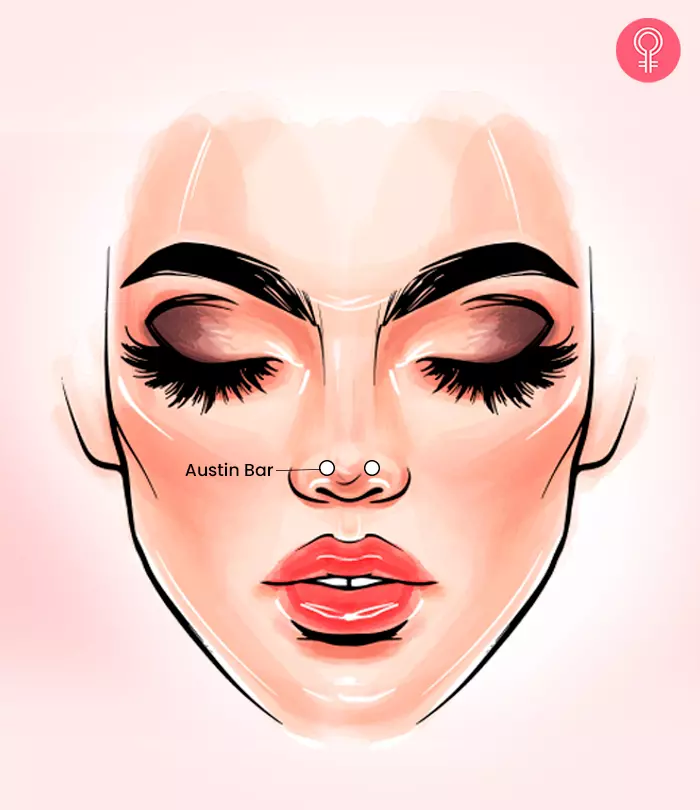
Image: StyleCraze Design Team
The Austin bar piercing is a straightforward yet unique type of nose piercing. It goes horizontally, right through the tip of your nose, without touching any cartilage or entering the nostrils. What you get is a small, straight bar that appears as a dot on each side of your nose tip. While this piercing is not something you see every day, it does make for a cool choice for people looking to stand out. It is especially meant for those trendsetters and individualists whose vibes standard piercings simply cannot capture. In this article, we have further discussed the Austin bar piercing process, the pain you can expect, the healing process and aftercare, and the associated risks. Continue reading to learn more.
 Piercing Guide: Cheek Piercing
Piercing Guide: Cheek Piercing- Placement: Horizontal bar at the tip of the nose
- Best Jewelry: Straight barbell
- Cost: $25 to $100
- Pain Level: Medium to high (6–7/10)
- Healing Time: 2 to 3 months
In This Article
Origin Of The Austin Bar Nose Piercing

There is a bit of enigma surrounding the origins of the Austin bar piercing. It is often linked to Austin, Texas, a city celebrated for its individuality and artistic spirit. Yet, the exact moment this piercing came into being is wrapped in obscurity. What we do know is that it emerged into the spotlight in the early 2000s and quickly became a symbol of unique self-expression. The piercing is also believed to be named after the first person known to showcase this daring look. The piercing was performed by the skilled London piercer Patrick Bartholomew; since then, the Austin bar piercing has continued to captivate those seeking a subtle yet bold statement.
 Did You Know?
Did You Know?While the origin of the piercing may not be clear, the process of getting one is simple and clear-cut. Check out the next section to learn more.
Key Takeaways
- An Austin bar piercing offers a unique, horizontal nose tip adornment.
- Healing takes 2-3 months with diligent aftercare.
- Costs vary, but expect $25-$100 for the piercing, plus jewelry.
- Jewelry options include straight and curved barbells.
- Opt for safe materials like titanium or high-quality gold.
- The typical gauge for this piercing is 16G or 14G.
- Risks include infection, migration, and longer healing times.
Process Of Getting An Austin Bar Nose Piercing
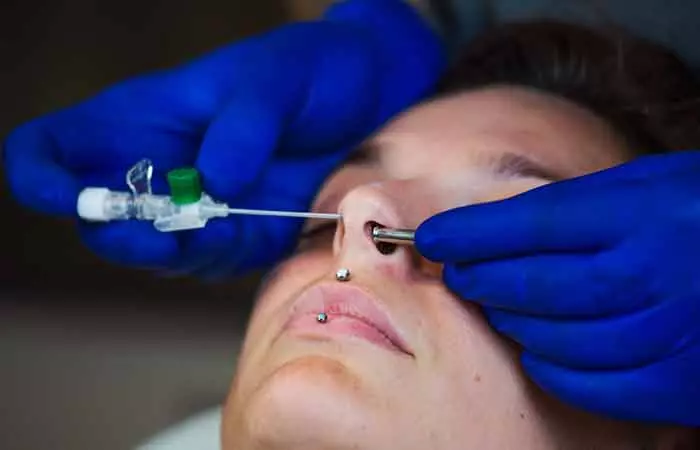
Similar to other types of piercings, the process begins with selecting an experienced piercer, someone who understands the uniqueness of such a piercing. The piercer starts by cleaning the area around the nose tip with an antiseptic solution to ensure a clean canvas for the body modification. Next, they mark the entry and exit points on the nose where the horizontal piercing will go through. These marks serve as the visual cue for what the Austin bar piercing will look like once it is done.
Once you give the green light, the piercer will use a sterilized piercing needle to create the piercing, swiftly passing it through the predetermined marks. The sensation is akin to a quick pinch—a brief, momentary shot of pain and discomfort for a standout piercing among other body modifications. Immediately after, the chosen Austin bar nose piercing jewelry, typically a straight barbell, is threaded through, completing the successful piercing experience.
The fresh Austin bar piercing is then cleaned again, and you are provided with detailed aftercare instructions to ensure a smooth healing process.
So what is the size of the needle used for this process? Read on to find out what gauge is most suitable for your Austin bar piercing to ensure optimal healing and a style that suits you perfectly.
What Gauge Is An Austin Bar Piercing?
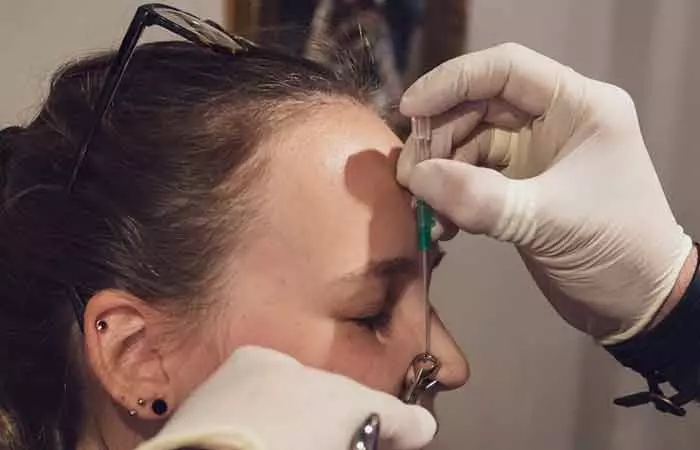
When it comes to the Austin bar piercing, selecting the right gauge is a key step. Typically, piercers will use a 16 gauge or 14 gauge needle for this type of piercing, which are ideal because they are not too thick or too thin. This makes for the right balance for a stable piercing that will heal well and securely hold the jewelry in place. It is important to work with your piercer to choose the best gauge for you, as this can depend on your individual anatomy and the specific look you are going for with your new piercing.
Now that you know about the piercing process, the next concern is definitely the pain level. Read the next section to find out what to expect.
Austin Bar Piercing Pain

When it comes to the Austin bar piercing, it is natural to wonder about the pain involved. Just like any piercing, the pain experienced varies from one individual to another, largely depending on one’s pain threshold and reaction to pain. However, most people would agree that the Austin bar piercing does pack a bit more of a punch compared to other nose piercings and barbell piercings. This is because it passes through a thicker section of the nose tip’s skin, which can be more sensitive, increasing the risk of infection and swelling. On a pain scale of 1 to 10, this piercing rates between 6 and 7, which is considerably painful.
That said, the piercing process is quick, and any sharp sensation is fleeting. After the initial discomfort, what follows might be a dull ache as you enter the healing phase. Nevertheless, a professional piercer’s technique and your state of relaxation can greatly influence your pain experience for the better.
Rest assured, any discomfort is temporary, and with excellent care and adherence to essential aftercare tips, you will soon be enjoying your new piercing with minimal pain as it heals.
Proper aftercare products and following your piercer’s guidance are key components of a successful Austin bar piercing journey. Learn more about the time taken to heal in the section below.
How Long Does A Bar Piercing Take To Heal?

Healing an Austin bar piercing generally takes between 2 to 3 months, provided you follow proper aftercare diligently. Keeping the area clean and avoiding disturbance to the piercing are crucial steps in the healing process. It is a bit of a commitment, but with consistent care, your Austin bar piercing should settle in nicely over these few months, ensuring a smooth healing process.
It is important to note that due to its unique placement, an Austin bar piercing is not recommended as a first piercing experience. For those new to piercings, it is wise to start with less complex piercings which are less intense, allowing you to become accustomed to the healing phase and care involved in maintaining body modifications.
For the aftercare phase, using recommended aftercare products and following rituals is something you need to do religiously, no matter what piercing you get. Excellent care is essential to prevent severe complications such as the risk of rejection, scarring, or infection. The next section delves into details regarding the aftercare process; check it out.
How To Care For An Austin Bar Piercing

Caring for your Austin bar piercing involves a few key steps to ensure it heals properly and stays looking great that are listed below:
- Keep your hands off the piercing unless necessary, and always clean your hands before contact.
- Keep makeup, hairspray, and perfumes away from the piercing site to prevent irritation.
- Do not swim in pools, lakes, or other potentially unclean water bodies while your piercing is healing.
- After cleaning, pat the area dry with disposable paper products rather than cloth towels, which could snag on the jewelry or introduce bacteria.
- Resist the urge to twist or turn the jewelry in the piercing, as this can cause irritation and hinder the healing process.
- Refrain from using harsh products such as alcohol or hydrogen peroxide to clean the piercing as these can slow down the healing process.
- Avoid smoking or using tobacco products and consuming alcohol. The toxins in these can interfere with the healing process (1).
- Gently clean the piercing with a saline solution or a piercing aftercare spray two times a day to fend off infection.
By keeping up with these aftercare practices, you will be providing the best environment for your Austin bar piercing to heal and reduce the chance of complications. Since keeping it clean and free of infection is of utmost importance, check out below how you can keep your fresh piercing clean.
How To Clean An Austin Bar Piercing

Cleaning your Austin bar piercing is a breeze if you stick to a simple routine:
- Creating a saline mix by mixing about 1/2 teaspoon of non-iodized salt into one cup of warm distilled water, stirring until the salt dissolves. Alternatively, you can opt for a ready-to-use piercing aftercare spray if you are in a rush.
- Soak a clean cotton ball/gauze in your saline solution for the actual cleaning, then gently dab it around the pierced area. There is no need to twist or turn your jewelry; just let the solution do its work.
- Once you have given it a good soak, take a piece of clean dry gauze or tissue to pat the area dry. Remember, the key is to be gentle to avoid any irritation.
Repeat this cleaning method twice a day and your Austin bar piercing should be on the fast track to healing nicely.

Now that you have got a handle on how to clean and care for your Austin bar piercing, let us shift gears and talk about the actual bling you will be sporting. Dive in and explore the types of jewelry to pick from to complement your new piercing perfectly.
Nose Jewelry For An Austin Bar Nose Piercing

Selecting jewelry for an Austin bar piercing is an exciting part of the process. Below is what you need to know about the different jewelry styles:
- Straight Barbell: This is the classic choice for an Austin bar piercing. It is a straight piece of jewelry that goes through the piercing with a bead on each end that is visible on the outside.
- Curved Barbell: While not as common for an Austin bar, a curved barbell can be used if the anatomy of your nose allows for a snug fit, adding an arch to the look.
- Austin Bar Chain: For those looking for additional flair, chains can be added to connect the beads of the Austin bar piercing across the bridge of the nose, making for a more intricate appearance.
Remember, the style you choose should not only match your personal aesthetic but also allow for comfortable healing and wear. Next, delve into the recommended materials that are both body-friendly and stylish for your Austin bar piercing.
Recommended Materials For Austin Bar Piercing

Selecting the right material for your Austin bar piercing jewelry is not just about looks—it is also about comfort and safety. Here are the top materials to consider:
- Implant-Grade Titanium:This is the gold standard for new piercings. Implant-grade titanium is not only resistant to body fluids and corrosion, but it is also hypoallergenic, which means it is less likely to cause an allergic reaction.
- 14 Karat Or 18 Karat Gold:If you are after a bit of luxury, gold is a solid choice. It is important to choose high-quality gold to minimize any risks of irritation or reaction from allergy-causing alloys.
- Surgical Stainless Steel: This is a budget-friendly option that is durable and resistant to corrosion. However, it is not the best pick if you are allergic to nickel.
- Niobium:Like titanium, niobium is hypoallergenic and comes in a variety of colors. It is a perfect choice if you want something a little different without compromising on safety.
When choosing the material for your Austin bar piercing, think long-term. You want something that will heal well, stand the test of time, and allow your piercing to flourish.
After you have picked your jewelry, figuring out expenses is the next big step. Scroll below to learn about the cost of getting an Austin bar piercing done.
How Much Does An Austin Bar Piercing Cost?

The cost of an Austin bar piercing can vary quite a bit, depending on where you go to get it done. Generally, you might find yourself paying somewhere between $25 to $100 for the piercing service itself. Keep in mind the piercer’s skill and the studio’s location can make a difference in price.
Additionally, the cost of the jewelry for your Austin bar piercing is often not included in the piercing fee, so you will want to factor that into your budget as well. The jewelry is a separate cost, and for a straight barbell, which is the standard choice, you could be looking at an additional $10 to $40. High-quality metals like titanium, which may be more expensive, are recommended to minimize the risk of complications and ensure the best healing process. It is best to have a meeting with your piercer prior to confirming an appointment to figure out the total budget for the process, including the jewelry so you are properly prepared.
Finally, understanding the potential risks and complications that can come with this unique nose piercing is essential to making an informed decision and ensuring you take the right precautions before and after getting pierced. Read on to learn more.
Risks And Complications Of Austin Bar Nose Piercing

While an Austin bar piercing can be a cool and eye-catching addition to your look, it is wise to be aware of potential risks and complications. Some of these are listed below:
- Migration:The jewelry may move from its initial placement, which can alter its appearance and possibly lead to the need for re-piercing.
- Rejection:Similar to how the body might push out a splinter, it can also reject a piercing (2). This may lead to scarring or warrant the removal of the piercing.
- Snagging: The barbell can easily get caught, causing sudden pain or even tearing if you’re not careful when dressing or using a towel.
- Infection:Recognizable by symptoms of bleeding or scarring, infections can extend healing time and may warrant medical attention (3).
- Swelling And Redness: Swelling is normal, but if it is excessive or persistent, it may be a signal that your body is reacting adversely to the piercing.
- Nasal Interference:Especially in the case of colds or allergies, blowing your nose can be tricky and uncomfortable with a fresh Austin bar piercing.
- Allergic Reactions: If the jewelry material is not compatible with your skin, it can cause an allergic response, necessitating a switch to a more biocompatible material (4).
- Prolonged Healing Time: Taking out the piercing jewelry prematurely can lead to closure and the possibility of having to repeat the piercing procedure.
- Pain:The Austin bar piercing is often reported to be more painful than other types. Hence, a higher pain tolerance or readiness to manage the discomfort is important.
Acknowledging these aspects of an Austin bar piercing helps prepare you for a successful healing journey and long-term satisfaction with your piercing.
Each nose piercing has its unique appeal, so understanding how they differ can help you choose the one that fits your vibe and comfort level.
Comparison With Other Piercings
The Austin bar piercing is a sleek and subtle option. On the other hand, the Mantis piercing, though also on the nose, is positioned vertically along the bridge, creating a long, narrow look, which is a bit different from the Austin bar’s horizontal style. Then there is the Nasallang piercing, which is more complex. It involves multiple piercings through both nostrils and the septum, all connected by one piece of jewelry. This piercing is more dramatic and requires a longer healing time because of the extra punctures. Among these types, Austin bar piercing is the most simple to perform, maintain, and heal.
The Austin bar piercing stands out as a distinct and edgy choice for nose adornment. Its unique horizontal placement makes it a conversation starter, and a statement of individualism. It appeals to those who have a penchant for the less conventional. If you are contemplating an Austin bar piercing, remember to reflect on the risks, choose the right materials and gauge, and follow the aftercare instructions to the letter. Unquestionably, this piercing is a testament to self-expression, and with the proper attention and care, it can be a wonderful addition to your personal style.
Frequently Asked Questions
Why choose an Austin bar nose piercing?
Choosing an Austin bar piercing can be a bold fashion statement, as it is both rare and provides a distinctive look with its placement at the tip of the nose.
Who shouldn’t get an Austin bar piercing?
Individuals who have never had a piercing before or those looking for a subtle addition should reconsider getting an Austin bar piercing due to its bold nature and the pain level involved.
What is the length of an Austin bar piercing?
The length of an Austin bar piercing will vary depending on the size of the individual’s nose, as it should be just long enough to accommodate the width of the nose tip comfortably.
How to deal with an infected Austin bar piercing?
If an Austin bar piercing becomes infected, it is important not to remove the jewelry, as this can trap the infection inside. Antiseptic solutions like betadine, isopropyl alcohol, or diluted hydrogen peroxide can be used to care for an infected Austin bar piercing. It is also important to consult with a healthcare provider for appropriate treatment.
Austin bar Vs. Nasallang piercings – what is the difference?
The main difference between an Austin bar and a nasallang piercing is that the Austin bar goes through the tip of the nose without piercing the cartilage, while the nasallang is a tri-nasal piercing that goes through both nostrils and the septum.
Austin bar piercings are unique and rare, making it a bold choice for individual style. Learn more about the pain level and healing time of this piercing from this informative video. Check it out below.
References
Articles on StyleCraze are backed by verified information from peer-reviewed and academic research papers, reputed organizations, research institutions, and medical associations to ensure accuracy and relevance. Read our editorial policy to learn more.
- Factors Affecting Wound Healing
https://www.ncbi.nlm.nih.gov/pmc/articles/PMC2903966/ - Complications of body piercing
https://pubmed.ncbi.nlm.nih.gov/16342832/ - Body piercing: complications and prevention of health risks
https://pubmed.ncbi.nlm.nih.gov/22175301/ - Face Piercing (Body Art): Choosing Pleasure vs. Possible Pain and Posture Instability
https://www.ncbi.nlm.nih.gov/pmc/articles/PMC3177080/
Read full bio of Eve Phillips
Read full bio of Aparna Harry
Read full bio of Madhumati Chowdhury
Read full bio of Vaishali Sinha







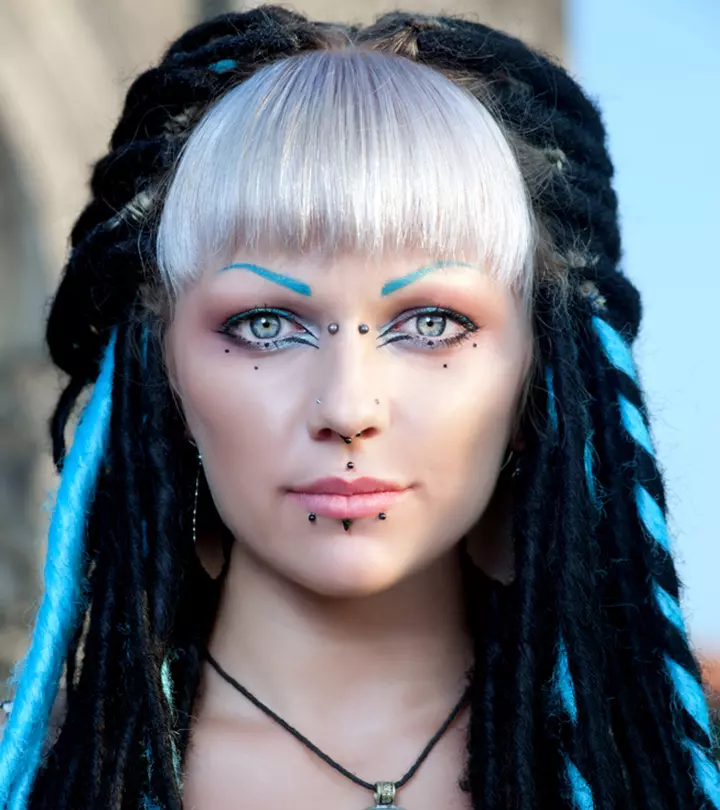















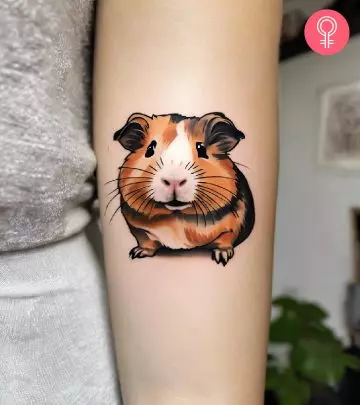



Community Experiences
Join the conversation and become a part of our empowering community! Share your stories, experiences, and insights to connect with other beauty, lifestyle, and health enthusiasts.